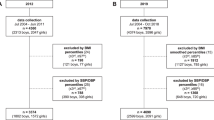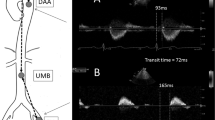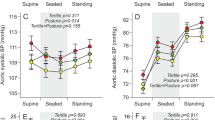Abstract
The enhanced wave reflection in small children is a well-known phenomenon. It is explained on the basis of differences in the body height and the timing of wave reflection. This hypothesis still has not been proved directly. The aim of our study was to determine the reference values of aortic augmentation index (Aixao) and the simultaneously measured return time of the systolic pulse wave (RT) in relation to the body height to test this hypothesis. Aixao and RT were measured by Arteriograph in a healthy population aged 3–18 years (n=4619, 2489 males). The Aixao decreased with increasing age in boys from 18.6±8.4% to 4.7±4.3% and in girls from 22.3±9.2% to 8.1±5.1%, whereas the RT increased from 115.5±16.3 ms to 166.7±20.8 ms in boys and from 106.7±21.9 ms to 158.1±15.5 ms in girls. These changes were constant during childhood, but they slowed down after the onset of puberty. Because aortic pulse wave velocity (PWVao) measured in the same population was unchanged during childhood, the increase of RT can only be explained by the increase of aortic length due to growth. In the puberty PWVao starts increasing indicating that RT (Aixao) does not follow the increase (decrease) of aortic length proportionally.
This is a preview of subscription content, access via your institution
Access options



Similar content being viewed by others
References
Shieh KY, O’Rourke MF, Avolio AP, Doherty B, Kelly RP, Chen Y . Pressure wave contour in the ascending aorta of children—paradoxical similarity to the elderly. Aust NZ J Med 1989; 19: 555.
Kelly R, Hayward C, Avolio AP, O'Rourke M . Noninvasive determination of age-related changes in the human arterial pulse. Circulation 1989; 80: 1652–1659.
Gevers M, van Genderingen HR, Lafeber HN, Hack WW . Accuracy of oscillometric blood pressure measurement in critically ill neonates with reference to the arterial pressure wave shape. Intens Care Med 1996; 22: 242–248.
Murakami T, Takeda A, Takei K, Ueno M, Yakuwa S, Yamazawa H et al. Aortic pressure wave reflection in children. Hypertens Res 2010; 33: 225–228.
Sugawara J, Hayashi K, Yokoi T, Tanaka H . Age-associated elongation of the ascending aorta in adults. JACC Cardiovasc Imaging 2008; 1: 739–748.
Rosario AS, Kurth BM, Stolzenberg H, Ellert U, Neuhauser H . Body mass index percentiles for children and adolescents in Germany based on a nationally representative sample (KiGGS 2003-2006). Eur J Clin Nutr 2010; 64: 341–349.
National High Blood Pressure Education Program Working Group on High Blood Pressure in Children and Adolescents. The fourth report on the diagnosis, evaluation, and treatment of high blood pressure in children and adolescents. Pediatrics 2004; 114 (2 Suppl 4th Report): 555–576.
Baulmann J, Schillings U, Rickert S, Uen S, Dusing R, Illyes M et al. A new oscillometric method for assessment of arterial stiffness: comparison with tonometric and piezo-electronic methods. J Hypertens 2008; 26: 523–528.
Horvath IG, Nemeth A, Lenkey Z, Alessandri N, Tufano F, Kis P et al. Invasive validation of a new oscillometric device (Arteriograph) for measuring augmentation index, central blood pressure and aortic pulse wave velocity. J Hypertens 2010; 28: 2068–2075.
Cole TJ, Green PJ . Smoothing reference centile curves: the LMS method and penalised likelihood. Stat Med 1992; 11: 1305–1319.
Pan H, Cole TJ . LMS Chartmaker, a programme to construct growth references using the LMS method. Version 2.43. 2010 http://www.healthforallchildren.co.uk/.
Hidvégi EV, Illyés M, Benczúr B, Böcskei RM, Lenkey Z, Rátgéber L et al. Reference values of pulse wave velocity in a healthy population aged between 3 and 18 years. J Hypertens 2012; 30: 2314–2321.
Van Meurs-Van Woezik H, Klein HW, Markus-Silvis L, Krediet P . Comparison of the growth of the tunica media of the ascending aorta, aorta isthmus and descending aorta in infants and children. J Anat 1983; 136: 273–281.
Voges I, Jerosh-Herold M, Hedderich J, Pardun E, Hart C, Gabbert D et al. Normal values of aortic dimensions, distensibility, and pulse wave velocity in children and young adults: a cross-sectional study. J Cardiovasc Magn Reson 2012; 14: 77–89.
Rammos S, Kramer HJ, Trampisch R, Kozlik ON, Krogmann M, Bourgeois M . Normalwerte des Wachstums der Aorta im Kindesalter. Herz 1989; 14: 358–366.
Taisto S, Manlhiot C, Slorach C, Bradley TJ, Hui W, Mertens L et al. Evolution of the arterial structure and function from infancy to adolescence is related to anthropometric and blood pressure changes. Arterioscler Thromb Vasc Biol 2012; 32: 2516–2524.
Glukhova MA, Frid MG, Koteliansky VE . Phenotypic changes of human aortic smooth muscle cells during development and in the adult vessel. Am J Physiol 1991; 261 (4 Suppl): 78–80.
Senzaki H, Akagi M, Hishi T, Ishizawa A, Yanagisawa M, Masutani S et al. Age-associated changes in arterial elastic properties in children. Eur J Pediatr 2002; 161: 547–551.
Wells SM, Walter EJ . Changes in the mechanical properties and residual strain of elastic tissue in the developing fetal aorta. Ann Biomed Eng 2010; 38: 345–356.
Strong JP, Malcom GT, McMahan CA, Tracy RE, Newman WP, Herderick EE et al. Prevalence and extent of atherosclerosis in adolescents and young adults: implication for prevention from the pathobiological determinants of atherosclerosis in youth. JAMA 1999; 281: 727–735.
Berenson GS, Srinivasan SR, Bao W, Newman WP, Tracy RE, Wattigney WA . Association between multiple cardiovascular risk factors and atherosclerosis in children and young adults. The Bogalusa heart study. N Eng J Med 1998; 338: 1650–1656.
Tuzcu EM, Kapadia SR, Tutor E, Ziada KM, Hobbs RE, McCarthy PM et al. High prevalence of coronary atherosclerosis in asymptomatic teenagers and young adults. Evidence from intravascular ultrasound. Circulation 2001; 103: 2705–2710.
Acknowledgements
This study was supported by the Hungarian National Research Foundation (OTKA) No.78480.
Author information
Authors and Affiliations
Corresponding author
Ethics declarations
Competing interests
MI owns shares in TensioMed Ltd, the company which manufactures the Arteriograph and other devices for measuring vascular stiffness. FTM was employed at TensioMed Ltd previously during the period of the examination. The remaining authors declare no conflict of interest.
Rights and permissions
About this article
Cite this article
Hidvégi, E., Illyés, M., Molnár, F. et al. Influence of body height on aortic systolic pressure augmentation and wave reflection in childhood. J Hum Hypertens 29, 495–501 (2015). https://doi.org/10.1038/jhh.2014.118
Received:
Revised:
Accepted:
Published:
Issue Date:
DOI: https://doi.org/10.1038/jhh.2014.118
This article is cited by
-
Impact of social isolation during COVID-19 on anthropometric data, quality of life, baseline physical activity and aortic pulse wave parameters in children and adolescents in two independent samples
Italian Journal of Pediatrics (2023)
-
Is There a Role for Imaging Youth at Risk of Atherosclerosis?
Current Atherosclerosis Reports (2023)
-
Pediatric obstructive sleep-disordered breathing is associated with arterial stiffness
European Journal of Pediatrics (2022)
-
Augmentation index, a predictor of cardiovascular events, is increased in children and adolescents with primary nephrotic syndrome
Pediatric Nephrology (2020)
-
Peak oxygen uptake, ventilatory threshold, and arterial stiffness in adolescents
European Journal of Applied Physiology (2018)



